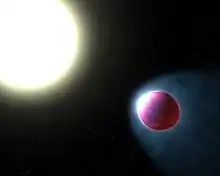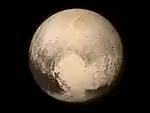WASP-121b
WASP-121b is an extrasolar planet orbiting the star WASP-121.[3][4] WASP-121b is the first exoplanet found to contain water in an extrasolar planetary stratosphere (i.e., an atmospheric layer in which temperatures increase as the altitude increases).[3][4] WASP-121b is in the constellation Puppis,[5] and is about 850 light-years from Earth.[6][3][7]
 Artist's impression of WASP-121b and its host star | |
| Discovery | |
|---|---|
| Discovery date | 2015[1] |
| Primary Transit[1] | |
| Orbital characteristics | |
| 0.02544 AU (3,806,000 km) | |
| Eccentricity | 0.0[1] |
| 1.275[1] d | |
| Inclination | 87.6°[1] |
| Star | WASP-121 |
| Physical characteristics | |
Mean radius | 1.81[2] RJ |
| Mass | 1.184[1][2] MJ |
Characteristics

WASP-121b is a "hot Jupiter" exoplanet with a mass about 1.18 times that of Jupiter and a radius about 1.81 times that of Jupiter.[2][3] The exoplanet orbits WASP-121, its host star, every 1.27 days.[2][3]
In 2019 a work by Hellard et al. discussed the possibility to measure the Love number of transiting hot Jupiters using HST/STIS. A tentative measurement of for WASP-121b was published in the same work.[8][9]
The planetary orbit is inclined to the equatorial plane of the star by 8.1°.[10]
Atmospheric composition
Spectral survey in 2015 have attributed 2,500 °C (4,530 °F), hot[3] stratosphere absorption bands to water molecules, titanium(II) oxide (TiO) and vanadium(II) oxide (VO).[1] The neutral iron was also detected in stratosphere of WASP-121b in 2020,[11][12] along with the neutral chromium and vanadium.[13] The detection claims of titanium(II) oxide (TiO) and vanadium(II) oxide (VO) were disproved in 2018 and 2020, respectively.[14]
Reanalysis of aggregated spectral data was published in June 2020. Neutral magnesium, calcium, vanadium, chromium, iron, and nickel, along with ionized sodium atoms, were detected. The low quality of available data do preclude a positive identification of any molecular species, including water. The atmosphere appears to be significantly out of chemical equilibrium and possibly escaping.[15] The strong atmospheric flows beyond Roche lobe, indicating ongoing atmosphere loss, were confirmed in late 2020.[10]
See also
| Wikimedia Commons has media related to WASP-121b. |
References
- Staff (2015). "Planet WASP-121 b". exoplanet.eu. Retrieved 3 August 2017.
- Staff (2017). "WASP Planets". wasp-planets.net. Retrieved 3 August 2017.
- Landau, Elizabeth; Villard, Ray (2 August 2017). "Hubble Detects Exoplanet with Glowing Water Atmosphere". NASA. Retrieved 2 August 2017.
- Evans, Thomas M.; et al. (2 August 2017). "An ultrahot gas-giant exoplanet with a stratosphere". Nature. 548 (7665): 58–61. arXiv:1708.01076. Bibcode:2017Natur.548...58E. doi:10.1038/nature23266. PMID 28770846. S2CID 205258293.
- Staff. "Finding the constellation which contains given sky coordinates". djm.cc. Retrieved 3 August 2017.
- Brown, A. G. A; et al. (2016). "Gaia Data Release 1. Summary of the astrometric, photometric, and survey properties". Astronomy and Astrophysics. 595. A2. arXiv:1609.04172. Bibcode:2016A&A...595A...2G. doi:10.1051/0004-6361/201629512. hdl:2445/125903. S2CID 1828208.Gaia Data Release 1 catalog entry
- Greicius, Tony (7 August 2018). "Water Is Destroyed, Then Reborn in Ultrahot Jupiters". NASA. Retrieved 15 November 2018.
- Hellard, Hugo; Csizmadia, Szilárd; Padovan, Sebastiano; Sohl, Frank; Rauer, Heike (2020). "HST/STIS capability for Love number measurement of WASP-121b". The Astrophysical Journal. 889 (1): 66. arXiv:1912.05889. Bibcode:2020ApJ...889...66H. doi:10.3847/1538-4357/ab616e. S2CID 209324250.
- waspplanets (19 December 2019). "The tidal shape of the exoplanet WASP-121b". WASP Planets. Retrieved 20 January 2020.
- Atmospheric Rossiter-McLaughlin effect and transmission spectroscopy of WASP-121b with ESPRESSO, 2020, arXiv:2011.01245
- Gibson, Neale P.; Merritt, Stephanie; Nugroho, Stevanus K.; Cubillos, Patricio E.; de Mooij, Ernst J. W.; Mikal-Evans, Thomas; Fossati, Luca; Lothringer, Joshua; Nikolov, Nikolay; Sing, David K.; Spake, Jessica J.; Watson, Chris A.; Wilson, Jamie (2020). "Detection of Fe I in the atmosphere of the ultra-hot Jupiter WASP-121b, and a new likelihood-based approach for Doppler-resolved spectroscopy". Monthly Notices of the Royal Astronomical Society. 493 (2): 2215. arXiv:2001.06430. Bibcode:2020MNRAS.493.2215G. doi:10.1093/mnras/staa228. S2CID 210714233.
- Cabot, Samuel H. C.; Madhusudhan, Nikku; Welbanks, Luis; Piette, Anjali; Gandhi, Siddharth (2020). "Detection of neutral atomic species in the ultra-hot jupiter WASP-121b". Monthly Notices of the Royal Astronomical Society. 494 (1): 363–377. arXiv:2001.07196. Bibcode:2020MNRAS.494..363C. doi:10.1093/mnras/staa748. S2CID 210838889.
- Ben-Yami, Maya; Madhusudhan, Nikku; Cabot, Samuel H. C.; Constantinou, Savvas; Piette, Anjali; Gandhi, Siddharth; Welbanks, Luis (2020). "Neutral Cr and V in the Atmosphere of Ultra-hot Jupiter WASP-121 B". The Astrophysical Journal. 897 (1): L5. arXiv:2006.05995. Bibcode:2020ApJ...897L...5B. doi:10.3847/2041-8213/ab94aa. S2CID 219573825.
- Mikal-Evans, Thomas; Sing, David K.; Kataria, Tiffany; Wakeford, Hannah R.; Mayne, Nathan J.; Lewis, Nikole K.; Barstow, Joanna K.; Spake, Jessica J. (2020). "Confirmation of water emission in the dayside spectrum of the ultrahot Jupiter WASP-121b". Monthly Notices of the Royal Astronomical Society. 496 (2): 1638–1644. arXiv:2005.09631. Bibcode:2020MNRAS.496.1638M. doi:10.1093/mnras/staa1628. S2CID 218684532.
- Hoeijmakers, H. J.; Seidel, J. V.; Pino, L.; Kitzmann, D.; Sindel, J. P.; Ehrenreich, D.; Oza, A. V.; Bourrier, V.; Allart, R.; Gebek, A.; Lovis, C.; Yurchenko, S. N.; Astudillo-Defru, N.; Bayliss, D.; Cegla, H.; Lavie, B.; Lendl, M.; Melo, C.; Murgas, F.; Nascimbeni, V.; Pepe, F.; Ségransan, D.; Udry, S.; Wyttenbach, A.; Heng, Kevin (2020), Hot Exoplanet Atmospheres Resolved with Transit Spectroscopy (HEARTS) IV. A spectral inventory of atoms and molecules in the high-resolution transmission spectrum of WASP-121 b, arXiv:2006.11308
External links
- SuperWASP Wide Angle Search for Planets: The Planets, SuperWASP.
- Pultarova, Tereza (3 August 2017). "Hubble Telescope Detects Stratosphere on Huge Alien Planet". space.com. Retrieved 3 August 2017.



